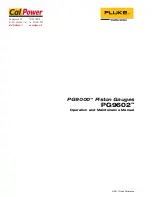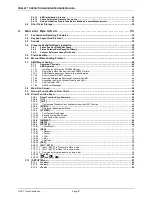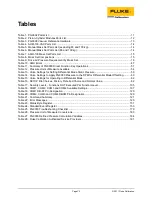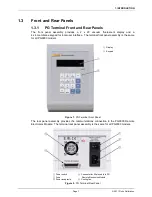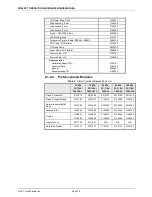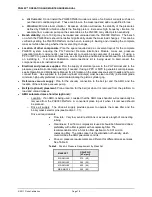
Page 1
© 2011 Fluke Calibration
1.
Introduction
1.1
Product Overview
PG9000 Piston Gauges are reference level pressure standards that operate on the piston
gauge principle. Pressure is defined by balancing it against the force exerted by a known mass
accelerated by gravity on the effective area of a piston-cylinder.
A PG9000 piston gauge consists of the PG9000 Platform, a piston-cylinder module and a mass set.
Optional hardware for vacuum reference operation is available. An optional automated mass handling
system is available. A PG9000 system typically includes the means to generate and adjust pressure and
the interconnection hardware to connect the system components and a device under test (“DUT”). The
pressure generation component can be manual or automated. COMPASS
®
for Pressure software may
also be included to assist in automating the tasks of executing test sequences, acquiring test data and
producing test reports.
The PG9000 Platform consists of the PG9000 Base, PG Terminal and Remote Electronics Module. Local
user interface is through the keypad and display on the PG Terminal. Remote communications and all on
board (built in) sensors are located inside or are connected to the Remote Electronics Module.
PG9000 is a family of piston gauges with common presentation and features designed to operate with a
mass set up to 100 kg. There are two PG9000 platforms – PG9602 and PG9607. They are both
designed for laboratories to realize and dissembinate fundamental pressure measurements.
The PG9602 uses type 7100/7600 gas operated gas lubricated piston cylinders to define
measurements in the range of 12 to 1 100 kPa. A 100 kg mass set allows for more overlap between
piston-cylinders across the working range.
The PG9607 uses a 50 mm piston-cylinder with controlled clearance capability to obtain dimensionally
traceable measurements in the range of 11 to 500 kPa. It is available on a limited basis and,
generally, is only offered for use in national measurement institutes or other laboratories performing
fundamental research in pressure metrology.
PG9000 platform, piston-cylinder module, mass set and optional automated mass handling system are
designed to maximize metrological performance and ease of operation. They include many features that
enhance the fundamental precision and stability of pressure measurements as well as simplifying use and
reducing operator influence on the measurements. The automated mass handler sits under the vacuum
bell jar thus allowing sustained low vacuum pull down without the need to break vacuum to effect a mass
load change. Extensive monitoring and controlling capability and advanced local and remote user
interfaces are integrated into the PG9000 Platform.
Operator interaction with PG9000 and its extensive capabilities and peripherals is accomplished through
a single display and keypad on the PG Terminal or from a computer via a RS232 or IEEE-488 interface.
Summary of Contents for PG9000 Series
Page 10: ...PG9602 OPERATION AND MAINTENANCE MANUAL 2011 Fluke Calibration Page X Notes...
Page 128: ...PG9602 OPERATION AND MAINTENANCE MANUAL 2011 Fluke Calibration Page 118 Notes...
Page 164: ...PG9602 OPERATION AND MAINTENANCE MANUAL 2011 Fluke Calibration Page 154 Notes...
Page 188: ...PG9602 OPERATION AND MAINTENANCE MANUAL 2011 Fluke Calibration Page 178 Notes...
Page 192: ...PG9602 OPERATION AND MAINTENANCE MANUAL 2011 Fluke Calibration Page 182 Notes...

